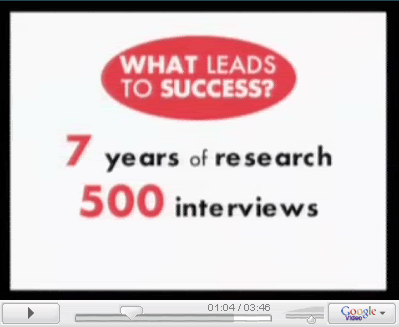Dear Friends,
I came accross this article Kim Roach posted on LifeHack.org about how to become a creative genius. I am reposting it here in the hope you will find it of value.
How to Become a Creative Genius
When we measure the creativity of young children, virtually all of them will record as being ‘highly creative’. However, only a small percentage of adults register as being ‘highly creative’.
What happened?
Schools have crushed creativity. We were told to color within the lines.
We were taught to follow instructions. The goal in school is to get the “right”
answer. Unfortunately, if you’re afraid to be wrong, you’ll never be creative or
original.
The job of education is to produce employees who follow instructions. And to this endeavor, they are doing a very good job. However, in terms of creativity, they are falling terribly short.
This is one of the most unfortunate realities in our current education system.
To undo this, we must continuallyexercise our creative juices. That’s why I have put
together 6 tips for expanding your creativity.
1. Keep a Notebook and
Pencil on hand at all times.
Ideas are like in-laws, you never know when they’re coming over to visit. By keeping a notebook around, you will always be able to capture your ideas at any time of the day.
Leonardo da Vinci was well known for keeping a journal of his ideas. His notebooks are now prized possessions that hold the many creative and genius thoughts of this master thinker, painter, and inventor.
His notebooks were filled with plans for flying machines, a parachute, a helicopter, the extendable ladder, the bicycle, folding furniture, and a number of automated tools for increasing productivity.
Yes, I am happy to say that Leonardo da Vinci was a productivity junkie.
A blank page is an open invitation for the creative and curious mind.
The simple act of writing gets you into a creative flow that can last for hours.
The free-flowing, exploratory practice of keeping a journal encourages freedom of thought and expanded perspectives.
2. The second key to
creativity is to ask questions.
Questions are the root of all knowledge and creativity. By continually asking Questions about the world around us, we fuel our creative fire.
Great minds are those that have asked the greatest questions.
Leonardo da Vinci asked such questions as:
“Why does the thunder last a longer time than that which causes it?” and “Why is the sky blue?”
Socrates asked such questions as:
“What is wisdom?”
“What is piety?”
“What is beauty?”
As a young boy,
Albert Einstein asked himself, “What would it be like to run beside a light beam
at the speed of light?”
A number of inventions have been created by asking one simple question…
“What if…..?”
By asking questions we increase our level of consciousness and our perspective of the world.
3. To become a creative genius, you must also be a voracious reader.
Reading enhances your mental ability and lets you experience the world from a brand new perspective.
When we read a book, we let go of our own perspectives and experience the world from the characters that have been crafted by the author.
I have found in my own life that the more I read, the more I want to know. Reading becomes an insatiable desire and an unquenchable thirst.
4. Seek out new experiences.
Our minds are much like a garden. Without proper care, the weeds will take over. Nothing sparks the mind like learning something new.
If you want to expand your creativity, then learn a new skill. It can be anything you choose. Learn a new language. Learn to water ski. Learn to play an instrument. Pick up photography or even try a new sport.
All of these activities get your mind working outside of its regular patterns.
5. Become a whole-brain thinker.
There are generally two-types of people in this world: left-brained and right-brained.
In most cases, people are either analytical thinkers who enjoy math, science, and logic or they are highly imaginative and creative individuals who focus on the big-picture.
Unfortunately, our school systems generally cater to those who are left-brained analytical thinkers. This has created a world of employees who are very good at following directions but are not so good at developing new ideas.
To break the mold, we must become whole-brain, holistic thinkers.
You can do this by using a powerful method known as mind mapping.
Mind mapping has been used by some of history’s greatest brains, including Michelangelo, Mark Twain, and Leonardo da Vinci.
Mind mapping is a whole-brain activity that will awaken your creative side as well as your analytical side.
Mind mapping will also help you to generate new ideas when needed. It doesn’t matter whether you’re using it for personal goal setting, problem solving, or simply to become a more creative, whole-brain thinker.
Our mind works in pictures, associating one idea to the next.
Mind mapping allows you to continue this natural thought process on paper.
Mind mapping is one of the most powerful tools for awakening your creativity.
For a detailed explanation of mind mapping, go to: http://en.wikipedia.org/wiki/Mind_map
6. The final tool for developing your creativity is imaginary dialogue.
Yes, I know, it may sound silly at first, but this technique can be an extremely powerful tool for developing your creativity.
This technique was first introduced in the best-selling book by Napoleon Hill, “Think and Grow Rich”.
Before achieving his success, Napoleon Hill was first meeting with an imaginary mastermind each night. He would close his eyes and visualize a table occupied by such great men as Abraham Lincoln, George Washington, Napoleon Bonaparte, Ralph Waldo Emerson, and Elbert Hubbard.
Napoleon Hill would then speak to the members of his imaginary mastermind in the following manner:
“Mr. Lincoln: I desire to build in my own character those qualities of patience and fairness toward all mankind and the keen sense of humor which were your outstanding characteristics.”
“Mr. Washington: I desire to build in my own character those qualities of patriotism and self-sacrifice and leadership which were your outstanding characteristics.”
“Mr. Hubbard: I desire to develop the ability to equal and even to excel the ability that you possessed with which to express yourself in clear, concise and forceful language.”
After meeting with his mastermind group for several months, he found that he had developed each of their desired characteristics into his own personality.
Napoleon also went to his imaginary mastermind to help solve any problem he was facing.
The imaginary mastermind is a master tool for finding new perspectives and looking at your problem from a different angle.
For example, let’s say that you own a business. Why not develop an imaginary mastermind of the greatest business minds in history? You can call to your table such names as Henry Ford, Andrew Carnegie, Walt Disney, Bill Gates, Ray Kroc, and Sam Walton.
Call on them daily for advice and you will begin to see your problems in a new light. As once said by Albert Einstein, “You can’t solve a problem with the same mind that created it.”
You can have even more creative fun by imagining a discussion between two different well-known people.
Some examples to get you started include:
Bill Gates Vs. Steve Jobs
Leonardo da Vinci vs. Albert Einstein
William Shakespeare vs. Maya Angelou
Let your mind wander and you will be surprised at all of the connections you begin to make.



































No comments:
Post a Comment